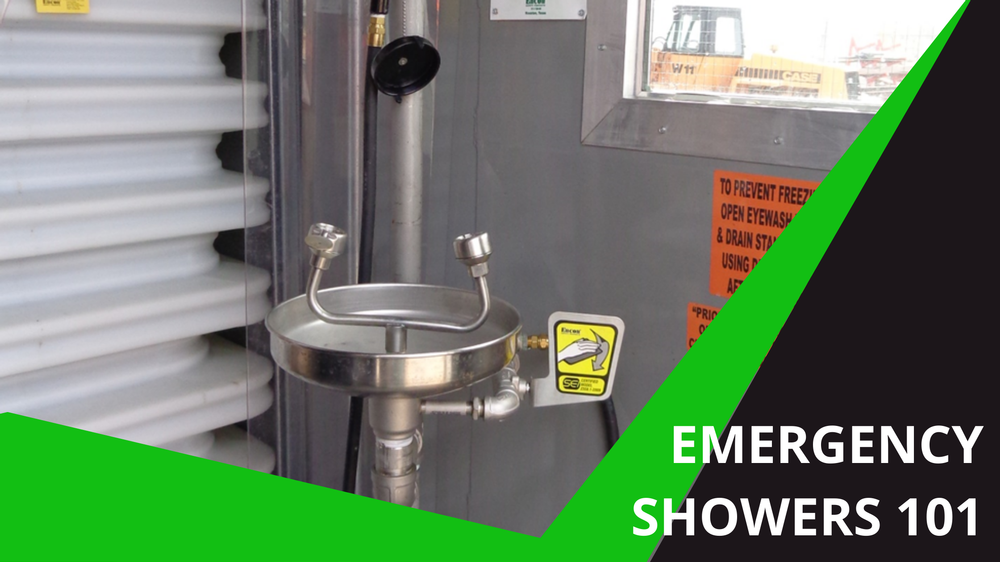Emergency Showers 101

Increased focus on employee safety has led to Governments tightening regulations around emergency showers. We have condensed the regulations into a quick read that will give you the need-to-know basics.
1.Why are Emergency Showers a Critical Addition to Your Safety System?
Even with the best controls and safety precautions in place accidents happen. It is important to take all the necessary steps to protect workers. The use of an emergency shower after exposure has been shown to reduce the risk of a deep tissue burn from 63% to 12.5%. Exposure to a dangerous chemical can cause long term damage to the skin and nerves. Immediate access to an emergency shower has shown reduced hospitalization times by approximately two weeks. Providing an ANSI compliant emergency shower not only protects workers but also protects the company from lengthy WCB claims and other liability.
2. How to tell if you need an emergency shower?
The government requires you to have an emergency shower depending on the chemicals that your employee is handling. Certain chemicals can be treated with an eyewash station alone, but the combination of a safety shower and eyewash station is the best way to be equipped in case of emergencies. Safety showers and eye wash stations release different pressures that are made for different rinsing purposes, it is important to be equipped with the proper equipment for the injury. The University of Guelf suggests a three-step process to determine if you need a safety shower.
- Audit the workplace to identify hazardous chemicals.
- Review Material Safety Data Sheets (MSDS) to see the recommended emergency instructions.
- Consult Environmental Health and Safety.
3. Emergency Shower Specifications
- Spray 20 gallons/ minute for 15 - 30 minutes depending on the chemical.
- Located no further away than 55ft (10 - 15 second walk) from the site of exposure.
- Easily accessible under all emergencies, such as loss of vision.
- Water flow begins in less than one second.
- A spray that reaches 20" x 60" in diameter.
- A minimum unobstructed area of 34" in diameter.
- Shower head must be between 82" - 96" from the floor.
- Flush fluid temperature between 16-38 degrees Celsius.
- Must be able to be activated without the use of the operators’ hands.
- Flushing fluid must be sealed from outside contaminates.
- Made of material that will not corrode.
4. Important Eye Specifications
- Spray 0.4 gallons/ minute for 15 - 30 minutes depending on the chemical.
- Located no further away than 55ft (10 - 15 second walk) from the site of exposure.
- Easily accessible under all emergencies, such as loss of vision.
- Water flow begins in less than one second.
- The spray simultaneously reaches both eyes at equal velocity.
- A minimum of 33” – 53” from the floor as well as a minimum distance of 6” from the wall.
- Must be able to be activated without the use of the operators’ hands.
- Flushing fluid must be sealed from outside contaminates.
5. Where should your emergency shower be located?
The first 10 to 15 seconds after exposure are crucial to preventing serious injury. The average person can only walk 55’ in 10 seconds. Your shower needs to be easily accessible under all emergencies, including loss of vision. The showers need to be located near the site of the hazard and be clearly marked. All workers should know the location of the shower before working with any hazardous material. Other aspects that you should consider is:
- Having the path to the shower clear of obstruction.
- Having the shower near an emergency exit for easy access in case emergency personnel are needed.
- Having the shower in the same room on the same floor as the hazard.
- Placing the shower in a safe location away from any hazards and electrical that could be dangerous when wet.
6. Important Considerations
How many workers are near the hazard? If there is a risk that more than one worker can be exposed multiple showers may be needed.
Alarm systems should be installed or come equipped on the shower to alert other workers that an accident has happened. This will ensure that the worker exposed to the hazard gets the assistance they need.
Extra clothing should be kept on hand for when clothing is contaminated with toxic substances.
Showers should be regularly serviced and cleaned to prevent unintended contamination.
For any inquiries about your safety shower needs please contact us at info@pro-gaurd.ca.